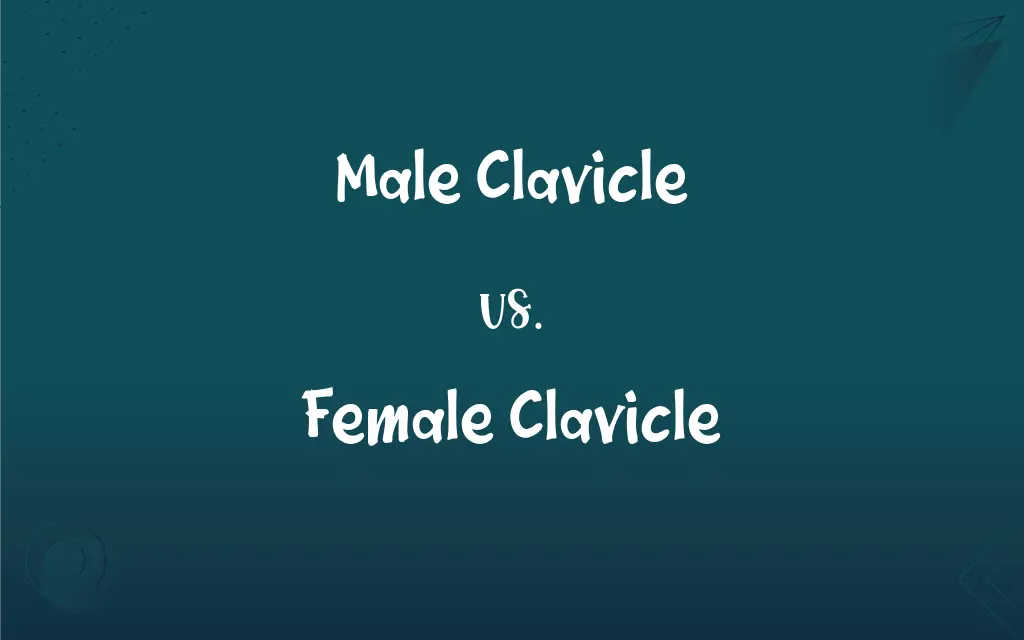Male Clavicle vs. Female Clavicle: What's the Difference?
By Aimie Carlson & Harlon Moss || Published on November 17, 2024
The male clavicle is generally larger and more robust, indicating greater muscle attachment and bone density, while the female clavicle is typically shorter and less curved, reflecting differences in skeletal structure and muscle mass.

Key Differences
The male clavicle, or collarbone, tends to be longer and more pronounced than its female counterpart, reflecting the broader shoulders and greater muscle mass typically found in males. This size difference aids in supporting a larger upper body and facilitating muscle attachment. In contrast, the female clavicle is usually shorter and more slender, aligning with the generally narrower shoulder width of females, which supports less muscle mass.
Regarding shape, the male clavicle is often straighter and has a more pronounced curvature towards the acromial end, which is associated with the need for wider range of motion and strength for physical activities. The female clavicle, meanwhile, tends to have a more gentle curvature, which is sufficient for the range of motion required by the female skeletal structure.
The ends of the clavicle also differ between genders. The sternal end of the male clavicle is broader and more robust, reflecting the attachment to the sternum and the need for strong support of the upper limb. In females, this end tends to be more tapered, indicating a less pronounced attachment area.
The angle at which the clavicle meets the sternum and the acromion (the outer end connecting to the shoulder) is generally more acute in males, facilitating the broader chest and shoulder width. In females, this angle is usually wider, complementing the narrower chest and aiding in the overall mobility of the shoulder.
Bone density and surface characteristics of the clavicle also vary, with males typically having a denser and more rugged surface to accommodate greater muscle attachments. Females tend to have a smoother clavicle surface, reflecting the lesser degree of muscle attachment and the different hormonal influences on bone density.
ADVERTISEMENT
Comparison Chart
Length
Longer
Shorter
Curvature
Straighter with pronounced curvature
More gentle curvature
Sternal End
Broader and more robust
More tapered
Angle with Sternum/Acromion
More acute
Wider
Bone Density and Surface
Denser with rugged surface
Smoother surface
ADVERTISEMENT
Male Clavicle and Female Clavicle Definitions
Male Clavicle
Supports greater upper body muscle mass.
The boxer's developed male clavicle was evident through his muscular physique.
Female Clavicle
Accommodates narrower shoulders and less muscle.
Her female clavicle was more slender, aligning with her physique.
Male Clavicle
Longer and straighter, aiding in broader shoulder support.
His male clavicle contributed to his wide shoulder frame.
Female Clavicle
Shorter and features a gentle curvature.
The gentle curvature of her female clavicle was noticeable.
Male Clavicle
Features a robust sternal end for sternum attachment.
The injury was located at the robust sternal end of his male clavicle.
Female Clavicle
Tapered sternal end for delicate sternum attachment.
The tapered sternal end of her female clavicle indicated a more delicate attachment.
Male Clavicle
Exhibits a pronounced curvature for muscle attachment.
The weightlifter's male clavicle showed pronounced curvature from years of training.
Female Clavicle
Smoother surface reflecting lesser muscle attachments.
The smooth surface of her female clavicle indicated lesser muscle attachments.
Male Clavicle
Denser bone structure for enhanced strength.
His dense male clavicle was less prone to fractures.
Female Clavicle
Wider angle with sternum for shoulder mobility.
Her female clavicle's wide angle facilitated shoulder mobility.
FAQs
Does the curvature of the clavicle affect shoulder mobility?
Yes, the curvature of the clavicle affects the range of motion and overall shoulder mobility, with differences accommodating male and female skeletal structures.
Why is the male clavicle straighter than the female clavicle?
The straighter male clavicle supports the broader shoulders and heavier muscle mass typically found in males.
Can you distinguish gender based on the clavicle alone?
While there are general trends, individual variation means that identifying gender based solely on the clavicle can be challenging.
Why is bone density important in the context of the clavicle?
Bone density impacts the strength and durability of the clavicle, with higher density supporting greater muscle mass and physical activity levels.
Are there any evolutionary reasons for the differences in male and female clavicles?
Evolutionary differences likely relate to differing roles and physical demands, with males historically requiring more upper body strength and females having different physical demands.
Does age affect the size and shape of the clavicle?
Age can influence clavicle size and shape, with growth patterns differing slightly between genders and changes occurring with age.
Is there a difference in clavicle fracture rates between genders?
Men may have a higher incidence of clavicle fractures due to greater engagement in physical activities that risk such injuries, but individual factors also play a significant role.
What is the main difference between a male and female clavicle?
The male clavicle is generally longer, denser, and more robust, supporting greater muscle mass, while the female clavicle is shorter, more slender, and has a smoother surface.
Is there a significant difference in the length of male and female clavicles?
Yes, male clavicles are generally longer to accommodate broader shoulders and muscle mass.
Can clavicle characteristics be used in forensic analysis?
Yes, clavicle characteristics can aid in forensic analysis, particularly in gender estimation, though with caution due to individual variation.
How does physical activity affect the male and female clavicle?
Physical activity can influence the robustness and muscle attachment points on the clavicle, with more pronounced effects in males due to greater muscle mass.
How does the angle at which the clavicle meets the sternum differ between genders?
Males typically have a more acute angle, supporting broader chests, while females have a wider angle for narrower chests.
What role does the sternal end of the clavicle play?
The sternal end connects the clavicle to the sternum, playing a crucial role in upper body mobility and strength.
Can clavicle shape be changed through exercise?
While exercise can strengthen muscles around the clavicle, the bone's shape is primarily determined by genetics and cannot be significantly altered through exercise.
Are clavicle differences noticeable at birth?
Differences are less pronounced at birth and become more noticeable with puberty and skeletal maturation.
How do muscle attachments to the clavicle differ between genders?
Males typically have more pronounced muscle attachments due to larger muscle mass, while females have smoother surfaces with less pronounced attachments.
How do hormonal differences affect the clavicle?
Hormones can influence bone density and growth patterns, potentially affecting the size and strength of the clavicle in males and females differently.
How does the female clavicle accommodate pregnancy?
While the clavicle itself does not directly accommodate pregnancy, the overall skeletal structure, including the clavicle's angle and length, supports changes in posture and weight distribution.
Does the clavicle play a role in respiratory function?
Indirectly, as the clavicle supports shoulder and chest movements that are integral to breathing, especially during deep inhalation.
Can clavicle differences impact posture?
Yes, the length and angle of the clavicle can influence shoulder alignment and overall posture, with gender-specific differences contributing to distinct posture patterns.
About Author
Written by
Aimie CarlsonAimie Carlson, holding a master's degree in English literature, is a fervent English language enthusiast. She lends her writing talents to Difference Wiki, a prominent website that specializes in comparisons, offering readers insightful analyses that both captivate and inform.
Co-written by
Harlon MossHarlon is a seasoned quality moderator and accomplished content writer for Difference Wiki. An alumnus of the prestigious University of California, he earned his degree in Computer Science. Leveraging his academic background, Harlon brings a meticulous and informed perspective to his work, ensuring content accuracy and excellence.







































































